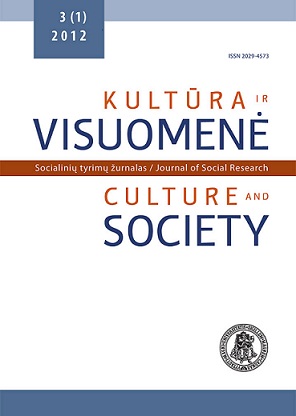Labor Division at Home and Procreational Intentions: the Case of Lithuanian Families
Labor Division at Home and Procreational Intentions: the Case of Lithuanian Families
Author(s): Jurga Bučaitė-VilkėSubject(s): Cultural Essay, Political Essay, Societal Essay
Published by: Vytauto Didžiojo Universitetas
Keywords: gender identity; gender roles; procreational intentions; family patterns; lyčių ideologija; lyčių vaidmenys; prokreaciniai ketinimai; šeimos modeliai
Summary/Abstract: Šiame straipsnyje siekiama atskleisti šiuolaikinės šeimos ir lyčių vaidmenų kaitos tendencijas. analizuojama, kaip besikeičiantys šeiminių santykių modeliai susiję su prokreaciniais ketinimais, kaip vertinami besikeičiantys lyčių vaidmenys ir lyčių lygybė tarpasmeninių santykių lygmenyje, kaip konstruojami šeimos modeliai, kuriame abu tėvai mokamą darbą derina su vaikų ugdymu. Straipsnyje remiamasi 2010–2011 metais atliktos reprezentatyvios reprodukcinio amžiaus gyventojų apklausos „lyčių nelygybė, viešoji politika ir gimstamumo ateitis Lietuvoje“ rezultatais, kurios tikslas buvo įvertinti lyčių socialinės nelygybės turinį, mastą ir tendencijas įvairiuose užimtumo sektoriuose ir šeimoje bei lyčių nelygybės poveikį gyventojų prokreacinėms nuostatoms. Tyrimo rezultatai rodo, kad egzistuoja dvejopas požiūris į tarpasmeninius šeimos santykius bei namų ūkio ir vaikų priežiūros pareigų pasidalijimą, kuris priklauso nuo įvairių sociodemografinių rodiklių – lyties, išsilavinimo ar gyvenamosios vietovės ir pan. atlikto tyrimo rezultatai patvirtina, kad moterys prisiima didesnę atsakomybę už namų ūkio bei vaikų priežiūros įsipareigojimus nei vyrai. The paper is based on the analysis of power structure of the family and the family decision- making concerning household responsibilities, including childcare and household duties. The tradi- tional institution of family has long been viewed as the basic unit of society and as a matter of public interests and public sphere. However, the increasing tendencies of individualization force individuals to accept the existence of distinction between male-breadwinner and female-career models. The traditional male breadwinner model is characterized by normative expectations of women and men’s duties and responsibilities shared in households. The modern families, as a consequence of individual decision-making, allow more diversity in sharing household labor. The main results of the survey conducted in 2010–2011 indicate that the most consistent predictor of the division of domestic labor in the private sphere is the dominant gender ideology of men, and both spouses/partners’ education, sex and place of residence. Compared to men, women share greater responsibility in taking care of children and housework. In this regard, the common satisfaction in family relations influences the restructuring of traditional gender roles. The asymmetries in family relations related to domestic labor are considered as one of the main factors characterizing the nature of gendered power relations in private and public spheres, including procreational behavior.
Journal: Kultūra ir visuomenė: socialinių tyrimų žurnalas
- Issue Year: III/2012
- Issue No: 1
- Page Range: 69-85
- Page Count: 17
- Language: English

